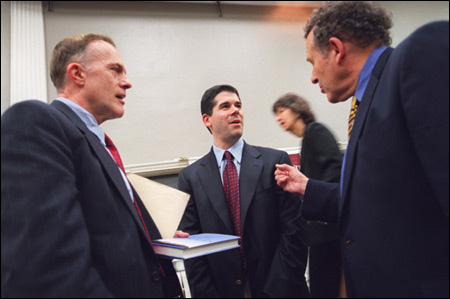Getting in is a personal matter
Author describes subjective nature of college admissions procedures

The No. 1 rule for gaining admission to a prestigious college, education writer Jacques Steinberg told an eager audience at the Graduate School of Education (GSE) Tuesday night (Sept. 24), is that there are no rules.
Admissions decisions are “messy, idiosyncratic, sometimes contradictory, occasionally arbitrary, and highly personal to the people who do this work,” said Steinberg, a New York Times writer.
He spent nearly a year following the admissions process at Wesleyan University in Middletown, Conn., for his new book “The Gatekeepers: Inside the Admissions Process of a Premier College” (Viking Press). Steinberg spoke about the surprisingly human, surprisingly messy business of college admissions at the GSE’s Askwith Education Forum.
With his very candid glimpse into the decision-making process of admissions officers, Steinberg has leveled the playing field of college admissions, said Harvard College Dean of Admissions and Financial Aid William Fitzsimmons in his introduction.
“The most surprising thing to me was really how human it was,” said Steinberg of his intimate look at the admissions process. “These were people who were making these calculations. Your application did not just arrive on campus and get fed into a computer.”
Steinberg chose Wesleyan as representative of the nation’s most selective 50 four-year colleges, he said. In the 1999-2000 season, the year he spent doing his research, the university received 7,000 applications for 700 places in the incoming class.
Despite the relatively small size of Wesleyan’s admissions staff, each application was read at least twice. About 400 applications – the most difficult decisions – were considered by committee in what Steinberg described as “sudden death”: For five days, the admissions staff discussed 80 applications for a strict five minutes each, deliberating then voting on the applicants’ fates.
Steinberg’s research methods, he admitted, were not much more scientific than the process he studied. He selected admissions officer Ralph Figueroa as his primary focus, he said, because he was the only one of Wesleyan’s senior admissions staff who did not own a dog or cat, to which Steinberg is very allergic. In the end, however, he gained unimpeded access to Wesleyan’s staff and their closed-door meetings, as well as to six student applicants who roughly represent the range of applicant profiles.
Wesleyan is similar to other schools of its type, said Steinberg, in its refusal to follow rules or formulas to compile its class. Grades matter, of course, but “the most important thing to them is the rigor of the curriculum,” he said. “Did the applicant take the hardest courses that the high school had to offer?”
The staff looked to quality over quantity of extracurricular activities, said Steinberg, favoring the student who worked steadily on one team or activity over several years, rising to a leadership role, to the dabbler who had joined every club in school. Variety counts, too: the varsity first baseman who also edits the newspaper has an edge.
Use of the SAT in deciding admission, said Steinberg, is particularly unbounded by hard and fast rules. “The bar is always moving,” he said, explaining that for a white applicant from a solid suburban high school, an SAT score of 1,400 would be expected, while a minority student from an urban school whose parents did not attend college might gain admission with a score of 1,100.
“What they feel they’re doing, as they admit the class, is building a community,” said Steinberg. That community must include tuba players and quarterbacks as well as a mix of blacks, whites, Hispanics, and Asians that enriches the lives of all the students, he said. “The goal, they will readily tell you, is not fairness.”
Not surprising for a process that assiduously avoids quantifying students, essays hold a lot of sway, Steinberg said. “They really can tip a decision,” he said.
The admissions essay should be true to the student, said Steinberg, cautioning that admissions officers are savvy in spotting essays that have been tweaked and advised by for-hire college counselors.
He told the story of Becca, one of the applicants he profiled, who wrote her essay about mistakenly accepting a pot brownie in high school and turning herself in to the principal. Wesleyan’s decision-makers, particularly Figueroa, applauded her candor.
Another applicant, Tiffany, wrote an interesting but not overwhelming essay about feng shui. Speaking with her after the admissions officers had made their decision, Steinberg learned that Tiffany had been an outspoken opponent of the death penalty and had written to inmates on death row since she was 14. Fearing that she might offend a conservative admissions officer, she steered clear of her passion in her essay.
“It really is so important not to try and second-guess what the admissions officers want to hear,” said Steinberg, adding that Figueroa, who read Tiffany’s application, also vigorously opposes the death penalty.
A Dartmouth College graduate, Steinberg wrote “The Gatekeepers,” which grew out of a New York Times series, in part out of his own curiosity about how he got into Dartmouth. He grew up in the southeastern Massachusetts town of Somerset and recognized several of its residents in the audience: his high school history teacher Bob Crouch, whom he credited with teaching him some of his most valuable writing lessons, and his parents, Barry and Edythe Steinberg.
“Tonight, they can say that their son talked his way into Harvard,” he quipped.




